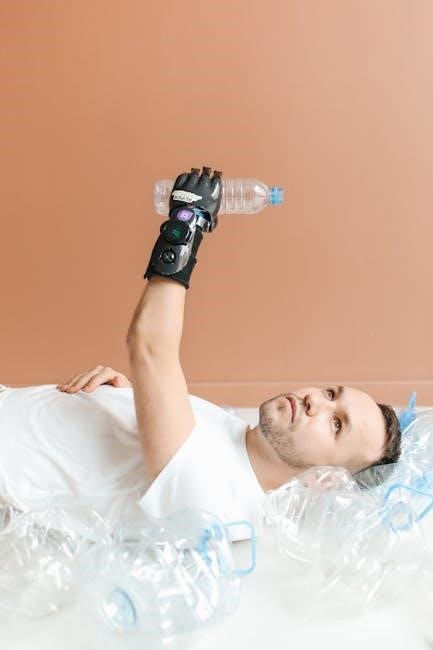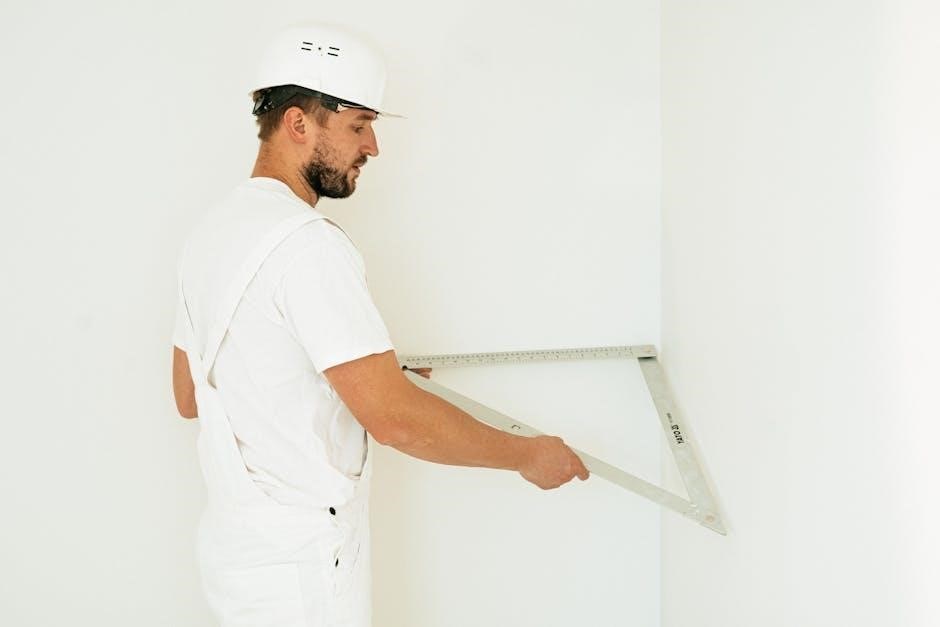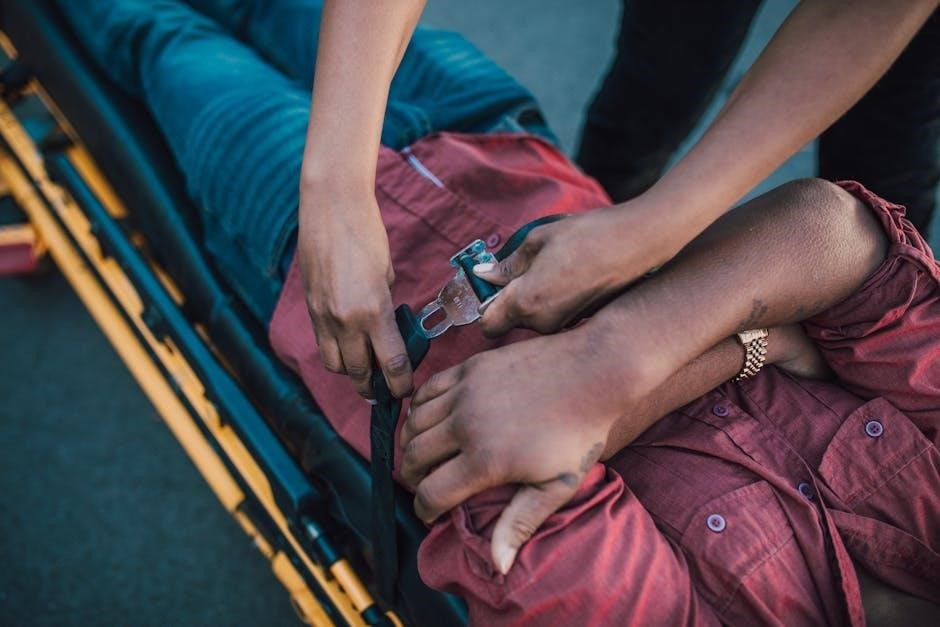Overview of the Sarmiento Brace
The Sarmiento Brace is a functional orthosis designed to treat humeral shaft fractures by stabilizing the bone, promoting healing, and allowing controlled movement during recovery.
1.1 What is a Sarmiento Brace?
The Sarmiento Brace is a specialized orthopedic device designed to treat humeral shaft fractures. It is a non-invasive, functional brace that immobilizes the fractured arm while allowing controlled movement. The brace is typically made of durable materials, such as plastic, and is worn over a stocking to ensure comfort. Its primary function is to stabilize the fracture, promote proper alignment, and facilitate healing. Unlike traditional casts, the Sarmiento Brace is adjustable and allows for some degree of motion, which can help prevent stiffness during recovery. It is a popular choice for treating upper arm fractures due to its effectiveness and ease of use.
1.2 Purpose of the Sarmiento Brace
The primary purpose of the Sarmiento Brace is to provide stability and immobilization for humeral shaft fractures, allowing the bone to heal properly. By applying compression and maintaining alignment, it helps restore bone integrity. The brace is designed to be non-invasive, eliminating the need for surgical intervention in many cases. It also enables limited arm movement, which can reduce stiffness and promote recovery. The Sarmiento Brace is particularly effective for fractures that are not severely displaced, offering a comfortable and practical alternative to traditional casting methods. Its adjustable design ensures a customizable fit for optimal support and healing outcomes.
1.3 Benefits of Using a Sarmiento Brace
The Sarmiento Brace offers numerous benefits, including effective fracture stabilization and enhanced patient comfort. It allows controlled movement, reducing stiffness and promoting faster recovery. Unlike traditional casts, it is lightweight and adjustable, providing a better fit. The brace is non-invasive, eliminating surgery risks, and its design enables easy monitoring of the fracture site. Patients often report higher satisfaction due to its comfort and mobility. It is cost-effective and widely used for humeral shaft fractures, making it a preferred treatment option for both patients and orthopedic specialists. These advantages contribute to improved healing outcomes and patient well-being during recovery.

Indications for Sarmiento Brace Usage
The Sarmiento Brace is primarily indicated for treating humeral shaft fractures, offering a non-surgical solution for stable, unstable, or comminuted fractures, promoting healing and alignment.
2.1 Types of Fractures Treated with a Sarmiento Brace
The Sarmiento Brace is effective for various humeral fractures, including transverse, oblique, and comminuted fractures. It is particularly suitable for stable and unstable fractures of the humeral shaft, providing necessary immobilization and alignment to facilitate proper healing. Additionally, it is used for fractures with minimal displacement or those at risk of malunion. Its design allows for controlled movement, making it ideal for fractures that require stabilization without surgical intervention. This brace is not recommended for fractures involving the shoulder or elbow joints or those with severe soft tissue damage.
2.2 When is a Sarmiento Brace Recommended?
The Sarmiento Brace is recommended for patients with humeral shaft fractures requiring stabilization without surgical intervention. It is ideal for fractures with minimal displacement or those at risk of malunion. The brace is typically used after initial immobilization, offering a conservative treatment option. It is particularly suitable for stable fractures where controlled movement is beneficial for healing. The brace is not recommended for fractures involving the shoulder or elbow joints or those with severe soft tissue damage. It is a preferred choice for nonoperative management, promoting proper alignment and reducing the risk of complications during recovery.
2.3 Contraindications for Sarmiento Brace Use
The Sarmiento Brace is not suitable for all fractures. It is contraindicated in cases of severe soft tissue damage or fractures involving the shoulder or elbow joints. Additionally, unstable fractures or those with significant displacement may not be ideal for this brace. Fractures requiring surgical intervention or those at high risk of malunion should avoid using the Sarmiento Brace. Proper evaluation by a healthcare provider is essential to determine if the brace is appropriate for the specific injury.

Application and Fitting of the Sarmiento Brace
Proper application involves wrapping the affected limb, securing the brace, and adjusting straps to ensure a snug, supportive fit without restricting blood flow or movement.
3.1 Preparing for Brace Application
Before applying the Sarmiento Brace, ensure the arm is clean and dry. Remove any jewelry or clothing that may interfere. Gently wash the skin with mild soap to prevent irritation. Dry thoroughly, especially in folds. If swelling is present, apply ice packs wrapped in a cloth to reduce it. Position the arm in a sling to maintain alignment and comfort. Ensure the arm is relaxed and supported before fitting the brace. Follow any specific instructions from your healthcare provider to prepare the limb for proper brace application and optimal healing.
3.2 Step-by-Step Instructions for Applying the Brace
Begin by placing the arm in a neutral position, slightly bent at the elbow. Carefully slide the brace over the arm, ensuring proper alignment with the fracture site. Secure the upper and lower sections using the provided straps, tightening them evenly. Adjust the compression to apply gentle pressure, following the manufacturer’s guidelines. Ensure the brace does not restrict circulation or cause discomfort. Double-check all straps and connections for stability. Finally, verify that the brace supports the arm correctly and allows for controlled movement as instructed by your healthcare provider.
3.3 Ensuring Proper Fit and Comfort
Proper fit is crucial for comfort and effectiveness. After applying the brace, check for even compression and alignment with the fracture site. Ensure the brace does not restrict blood flow or cause numbness. Adjust straps as needed to avoid tight spots. Regularly inspect for signs of irritation or pressure points. If discomfort persists, consider padding or consulting a healthcare provider. Periodically reassess the fit as swelling decreases or healing progresses. Proper fit ensures optimal support, promotes healing, and minimizes the risk of complications;

Daily Care and Maintenance
Daily care involves regular cleaning and checking the brace’s fit to prevent skin issues. Monitoring tightness ensures proper support without restricting movement. Keep the area clean and dry to promote healing and comfort.
4.1 Cleaning and Hygiene Tips
Regular cleaning of the Sarmiento Brace is essential to maintain hygiene and prevent odors. Use a soft cloth dampened with mild soap and water to wipe down the exterior. Avoid submerging the brace in water or using harsh chemicals, as this may damage the materials. Allow the brace to air dry completely before reapplying. Additionally, wash the stockinette liner frequently to keep the skin dry and reduce irritation. Proper hygiene practices help ensure comfort and promote a healthy recovery environment. Always follow the manufacturer’s cleaning instructions to maintain the brace’s integrity and effectiveness.
4.2 Monitoring Brace Tightness
Regularly check the tightness of the Sarmiento Brace to ensure proper fit and avoid discomfort. The brace should be snug but not overly tight, as excessive pressure can restrict blood flow or cause nerve irritation. Adjust the straps as needed, using the buckle system provided. Check tightness daily, especially after periods of inactivity or swelling. If you experience tingling, numbness, or increased pain, loosen the brace slightly. Avoid over-tightening, as this can impede healing or cause additional complications. Proper monitoring ensures the brace remains effective and comfortable throughout the recovery process.
4.3 Managing Discomfort or Irritation
Some discomfort is normal when using a Sarmiento Brace, but it should not be severe. If irritation occurs, check for tightness or improper fit. Adjust the straps to relieve pressure points. Use padding or soft materials to cushion areas prone to irritation. Gently massage the skin around the brace to improve circulation. Avoid scratching under the brace, as this can worsen irritation. If pain or swelling persists, consult your healthcare provider. Regular exercises, as recommended, can also help reduce stiffness and improve comfort during recovery. Proper management ensures the brace remains tolerable and effective for healing.

Exercises and Mobility
Gentle shoulder and elbow exercises are crucial to maintain upper limb mobility while using the Sarmiento Brace, preventing stiffness and promoting recovery.
5.1 Importance of Shoulder and Elbow Exercises
Shoulder and elbow exercises are vital during Sarmiento Brace use to maintain joint mobility and prevent stiffness. Immobilization can lead to reduced range of motion, so gentle movements are recommended. These exercises help strengthen surrounding muscles, ensuring proper healing and functional recovery. Patients should perform daily routines, such as shoulder rotations and elbow bends, to avoid long-term limitations. Regular exercise also promotes blood circulation, which supports the fracture healing process. Neglecting these exercises may result in difficulty straightening the arm or moving the shoulder after brace removal;
5.2 Recommended Exercises During Brace Use
During Sarmiento Brace use, patients are encouraged to perform gentle shoulder and elbow exercises to maintain mobility and strength. These include shoulder rotations, elbow bends, and wrist movements. Passive stretching, such as assisted arm elevation, can also be beneficial. Avoid heavy lifting, bending, or activities that strain the fracture site. Regular exercise helps prevent stiffness and promotes functional recovery. Consistency is key to ensuring proper healing and restoring arm function. Patients should follow a daily routine as prescribed by their healthcare provider to maximize recovery outcomes while using the brace.
5.3 Avoiding Overexertion and Injury
Avoiding overexertion is crucial while using the Sarmiento Brace to prevent further injury or delaying healing. Patients should refrain from heavy lifting, bending, or activities that strain the affected arm. Avoid sudden movements or twisting that could disrupt the fracture site. It’s important to listen to your body and rest when discomfort arises. Overexertion can lead to complications, such as prolonged healing or brace malfunction. Always prioritize gentle, prescribed exercises and avoid unsupervised physical activities. Consult your healthcare provider if unsure about safe activity levels to ensure proper recovery and brace effectiveness.

Follow-Up and Monitoring
Regular follow-up appointments are essential to monitor fracture healing and ensure proper brace fit. Your healthcare provider will check for alignment, swelling, and progress in recovery.
6.1 Schedule for Follow-Up Appointments
Follow-up appointments are typically scheduled every 2-4 weeks to monitor progress. Initial visits ensure proper brace fit and healing, while subsequent appointments assess bone alignment and recovery. Adjustments to the brace may be made to accommodate swelling or to promote proper fracture stabilization. Regular X-rays are often required to evaluate the fracture’s healing process. Consistent attendance to these appointments is crucial for ensuring a successful recovery and preventing complications. Your healthcare provider will tailor the follow-up schedule based on individual healing progress and specific fracture requirements.
6.2 What to Expect During Follow-Up Visits
During follow-up visits, patients can expect a thorough examination of the fracture site. The healthcare provider will assess the brace fit, ensuring it remains secure and properly aligned. X-rays are commonly taken to monitor bone healing and alignment. Patients may be asked about their comfort level, any pain, or mobility issues. Adjustments to the brace or treatment plan may be made based on the findings. Open communication with the provider is encouraged to address any concerns or questions. These visits are essential to ensure the fracture is healing correctly and to prevent potential complications.
6.3 Signs of Complications to Watch For
Patients should monitor for signs of complications, such as increased pain, numbness, tingling, or swelling in the arm or hand. Redness or warmth around the brace may indicate infection. If the brace feels too tight or causes difficulty moving the elbow or shoulder, this could signal improper fit. Additionally, if the fracture site becomes misaligned or healing is delayed, it may require further intervention. Any unusual symptoms should be reported to the healthcare provider immediately to address potential issues promptly and prevent long-term damage.

Removal and Recovery
The Sarmiento Brace is typically removed after fracture healing, usually within 8-12 weeks. Proper removal by a healthcare provider ensures safety, preventing further injury or discomfort.
7.1 When is the Brace Removed?
The Sarmiento Brace is typically removed once the fracture has healed sufficiently, usually after 8-12 weeks; The exact timing depends on the fracture type, healing progress, and patient health. Radiological confirmation of bone union is essential before removal. Only a qualified healthcare provider should remove the brace to ensure proper assessment and avoid complications. Early removal can hinder recovery, while delayed removal may slow mobility restoration. Patients are advised to follow their doctor’s guidance for the optimal removal timeline to ensure a safe and effective recovery process.
7.2 Process of Brace Removal
The removal of the Sarmiento Brace is a careful process performed by a healthcare professional. It begins with a thorough radiological assessment to confirm fracture healing. Once cleared, the brace is gently dismantled, often in a controlled medical setting. The patient is prepared by cleaning the skin and removing any padding. The brace is then slowly taken off, ensuring no discomfort or damage to the healing bone. Post-removal, the arm is assessed for mobility and strength, and further rehabilitation plans are discussed to restore full function and range of motion.
7.3 Post-Removal Care and Rehabilitation
After the Sarmiento Brace is removed, patients enter a critical phase of recovery. Gentle exercises are introduced to restore elbow and shoulder mobility, focusing on flexion, extension, and rotation. Physical therapy plays a key role in strengthening muscles weakened by immobilization. Patients are advised to avoid heavy lifting or strenuous activities until full strength is regained. Regular follow-ups with healthcare providers ensure proper healing progress. Additionally, ice therapy or heat treatments may be recommended to reduce stiffness and inflammation, aiding in the return to normal arm function and daily activities.

Common Challenges and Solutions
Common challenges include limited arm mobility, skin irritation, and emotional distress. Solutions involve gentle exercises, proper brace fitting, and psychological support to ensure a smooth recovery process.
8.1 Dealing with Limited Arm Mobility
Limited arm mobility is common when using a Sarmiento Brace. To address this, perform gentle shoulder and elbow exercises as recommended by your healthcare provider. Use a sling for additional support during healing. Avoid bending or lifting heavy objects to prevent strain. Gradually increase movement to restore flexibility and strength. Consistency in exercises and adherence to brace instructions are key to improving mobility without compromising the fracture’s stability. Patience and proper care ensure a smoother recovery process and better functional outcomes for the arm.
8.2 Managing Itching or Skin Irritation
Itching or skin irritation under the Sarmiento Brace can occur due to moisture or tightness. To manage this, ensure proper cleaning and drying of the skin before reapplying the brace. Use hypoallergenic materials and avoid harsh soaps. If irritation persists, consider using anti-itch powders or creams, but consult your doctor first. Avoid scratching, as this may worsen irritation. Regularly inspect the skin for redness or rashes and adjust the brace fit if necessary. Follow specific care instructions to maintain hygiene and prevent discomfort during recovery.
8.3 Addressing Emotional or Psychological Impact
Using a Sarmiento Brace can lead to emotional challenges, such as frustration or anxiety, due to limited mobility and lifestyle changes. It’s important to stay informed about the recovery process and set realistic expectations. Engaging in mental health practices, like mindfulness or counseling, can help manage stress. Connecting with support groups or sharing experiences with others who have used the brace can provide emotional relief. Maintaining a positive outlook and focusing on gradual progress can ease the psychological impact. A strong support system, including family and healthcare providers, plays a crucial role in coping with these challenges effectively.

Additional Support and Accessories
Additional support includes slings for immobilization and stockinettes for comfort. Accessories like padding or straps can enhance brace comfort. Physical therapy is often recommended for recovery support.
9.1 Use of Slings for Additional Support
A sling is often used alongside the Sarmiento Brace to provide additional immobilization and support, especially during the initial healing phase. It helps reduce arm movement, minimizing discomfort and preventing further injury. Slings are typically worn over the brace and are made of breathable materials for comfort. They are particularly useful for patients who need extra stability or have limited mobility. Proper fit is crucial to avoid constriction or nerve compression. Slings are usually recommended for short-term use to ensure joint mobility is maintained during recovery.
9.2 Accessories to Enhance Brace Comfort
Accessories like padding, breathable liners, and adjustable straps can significantly enhance the comfort of the Sarmiento Brace. Padding is often placed at pressure points to reduce discomfort and prevent skin irritation. Breathable liners help manage moisture, keeping the skin dry and reducing the risk of rashes. Adjustable straps allow for a customized fit, ensuring the brace does not feel too tight or restrictive. These accessories are especially beneficial for long-term use, improving overall wearability and patient adherence to treatment. They are widely available and can be tailored to individual needs for optimal comfort during recovery.
9.3 Role of Physical Therapy
Physical therapy plays a crucial role in the recovery process when using a Sarmiento Brace. It helps restore mobility, strength, and function to the affected arm and shoulder. Gentle exercises are introduced to prevent stiffness and maintain joint flexibility. As healing progresses, physical therapy incorporates gradual resistance and range-of-motion exercises to rebuild muscle strength. A tailored program ensures a smooth transition from brace use to independent movement. Regular sessions with a physical therapist are essential to achieve optimal recovery and prevent long-term limitations in arm function. This support is vital for regaining full mobility and confidence after a humeral fracture.

Patient Testimonials and Experiences
Patient experiences highlight the Sarmiento Brace’s effectiveness in supporting recovery, with many sharing stories of improved mobility and comfort during healing. Emotional and psychological challenges are common, but testimonials emphasize the brace’s role in restoring independence and confidence, aiding overall recovery journeys.
10.1 Real-Life Stories of Sarmiento Brace Users
Patients who have used the Sarmiento Brace often share stories of how it aided their recovery journey. Many users highlight the brace’s ability to stabilize their fracture while allowing gradual movement, which helped maintain joint mobility. Emotional challenges, such as initial frustration with limited arm use, are common, but users emphasize the brace’s role in restoring independence. Several testimonials mention the psychological impact of wearing the brace, noting how it provided a sense of security during healing. Overall, real-life experiences underscore the brace’s effectiveness in supporting both physical and emotional recovery processes.
10.2 Common Feedback and Insights
Common feedback from Sarmiento Brace users reveals consistent themes. Many appreciate the brace’s effectiveness in stabilizing fractures and promoting healing. Users often mention the importance of adhering to wearing instructions to avoid complications. Some highlight the need for proper fitting to ensure comfort and adequate support; Feedback also emphasizes the role of physical therapy in maximizing recovery outcomes. Overall, insights suggest that while the brace requires adjustment, its benefits in fracture management are significant, making it a valuable treatment option for humeral shaft fractures.
10.3 Tips from Experienced Patients
Experienced patients emphasize maintaining arm mobility through regular exercises and adhering to prescribed physical therapy routines. They recommend monitoring brace tightness daily to prevent discomfort and ensuring proper fit. Using a sling for additional support during daily activities is also advised. Keeping the brace clean and dry helps prevent skin irritation. Patients stress the importance of attending all follow-up appointments to address any issues promptly; Staying patient and consistent with brace usage is crucial for optimal healing. Open communication with healthcare providers ensures any concerns are resolved early, enhancing the overall recovery experience.
Comparison with Other Treatment Options
The Sarmiento Brace offers controlled mobility, making it a non-invasive alternative to casting or surgery, providing effective fracture stabilization with improved comfort and recovery outcomes for patients.
11.1 Sarmiento Brace vs. Traditional Casting
The Sarmiento Brace differs from traditional casting by allowing controlled mobility, reducing muscle atrophy and joint stiffness. Unlike rigid casts, it promotes functional recovery while stabilizing fractures. Patients often find it more comfortable due to its adjustable design and lightweight materials. However, traditional casting may be preferred for complex fractures requiring strict immobilization. The Sarmiento Brace is favored for its balance of support and mobility, enhancing healing and comfort compared to conventional plaster casts. It is particularly beneficial for humeral shaft fractures, where controlled movement aids in recovery without compromising fracture stability.
11.2 Sarmiento Brace vs. Surgical Interventions
The Sarmiento Brace offers a non-invasive alternative to surgical interventions for humeral shaft fractures. It avoids the risks associated with surgery, such as infection or nerve damage, while promoting fracture healing through controlled immobilization. Surgical interventions, like intramedullary nailing or plate fixation, are typically reserved for complex or unstable fractures. The Sarmiento Brace is preferred for its non-surgical approach, allowing patients to avoid the recovery time and complications associated with surgery. However, surgery may be necessary for fractures that cannot be effectively managed with bracing alone, ensuring proper alignment and stability in severe cases.
11.3 Sarmiento Brace vs. Other Fracture Braces
The Sarmiento Brace stands out among other fracture braces due to its unique functional design, allowing controlled movement to enhance healing. Unlike rigid casts or splints, it promotes early mobilization, reducing stiffness. Compared to U-slab splints, which are often temporary, the Sarmiento Brace offers longer-term stability and comfort. It is specifically tailored for humeral shaft fractures, providing superior compression and alignment. This specialized design makes it more effective than general-purpose braces, ensuring optimal recovery outcomes for patients with upper arm fractures.
The Sarmiento Brace is a highly effective treatment for humeral fractures, promoting natural healing and mobility. Adherence to instructions ensures optimal recovery and long-term functional outcomes.
12.1 Summary of Key Points
The Sarmiento Brace is a functional orthosis designed to treat humeral shaft fractures by stabilizing the bone, promoting healing, and allowing controlled movement during recovery. It is typically applied after initial immobilization and requires regular follow-up appointments to ensure proper fit and healing progress. The brace uses compression to stabilize the fracture, and its design allows for some degree of mobility, which helps prevent stiffness. Patients are often advised to use slings for additional support and to perform shoulder and elbow exercises to maintain mobility. Proper care, including cleaning and monitoring brace tightness, is essential to avoid complications. The brace is a conservative treatment option that has been shown to be effective in healing humeral fractures without surgical intervention. Adherence to the provided instructions and maintaining a consistent rehabilitation routine are crucial for achieving a successful recovery. By following these guidelines, patients can optimize their healing process and return to normal activities more efficiently.
12.2 Importance of Adherence to Instructions
Adhering to the instructions for using the Sarmiento Brace is crucial for effective healing and preventing complications. Proper application, regular follow-ups, and consistent exercise routines ensure the brace functions as intended. Neglecting to follow guidelines can lead to improper healing, discomfort, or prolonged recovery. Patients must prioritize brace maintenance, including cleaning and monitoring tightness, to avoid skin irritation or mobility issues. By strictly following medical advice, individuals can maximize the brace’s benefits, achieve optimal recovery, and minimize the risk of long-term complications. Compliance with instructions is essential for a successful and timely return to normal activities.
12.3 Long-Term Outlook for Recovery
The long-term outlook for recovery with the Sarmiento Brace is generally positive, with most patients achieving full strength and mobility in the affected arm. Proper use of the brace, combined with adherence to rehabilitation exercises, typically leads to complete healing within 8-12 weeks. Some individuals may experience minor long-term flexibility limitations, but these are rare; The brace’s design allows for functional movement during recovery, reducing the risk of stiffness. With consistent physical therapy and proper care, patients can expect a full return to normal activities, making the Sarmiento Brace an effective treatment for humeral shaft fractures.




